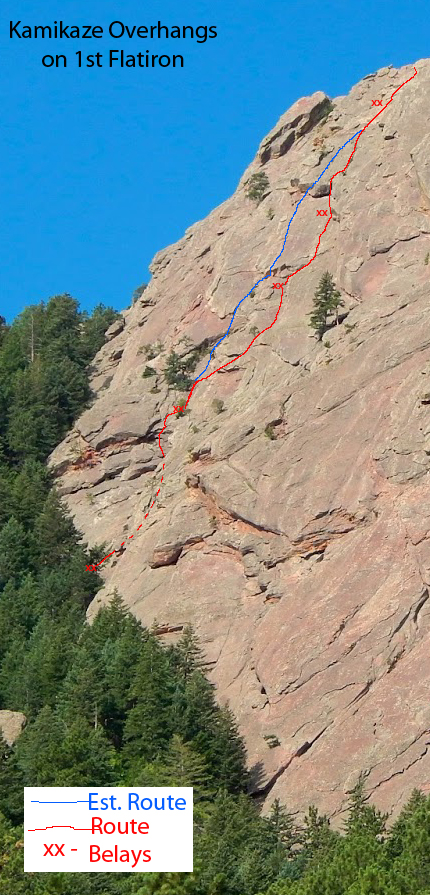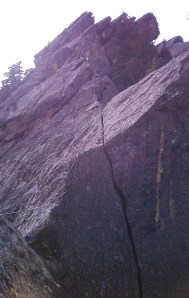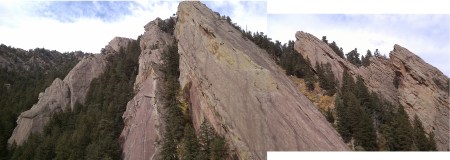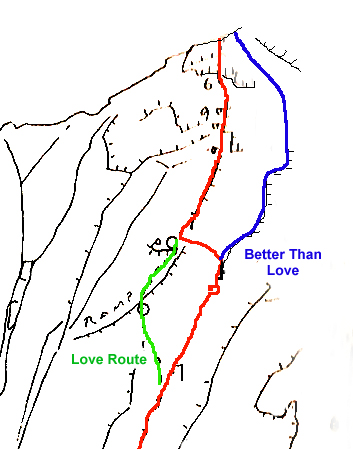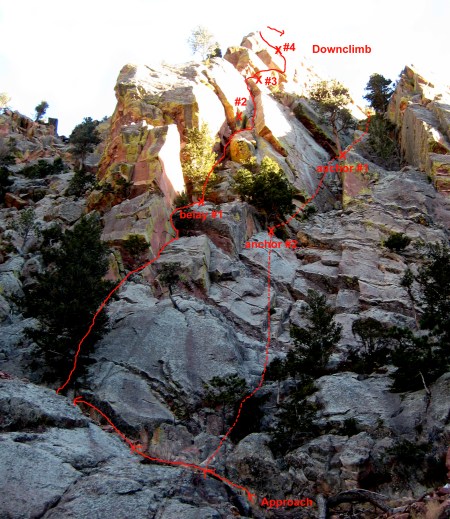October 19, 2013
For a cold but clear late October Saturday morning, Brian had identified a new route on the 1st Flatiron as a target for our ongoing, weekly search for exercise and adventure.
And he was so right, aided by a bit of poor preparation by the Joe and Brian team.
While it is a Cardinal sin of climbing to fail to prepare due to mere laziness, in this instance our lack of preparation might just have been the flavoring that made the day so good. Perhaps there is an argument for purposefully leaving without all the information just for the sport of living by your wits.
From my own CliffsNotes: Rules, Laws, etc.
- Climber’s Luck Maxim: luck is not an attribute, but rather a symptom of preparation (with a nod to Branch Rickey); good preparation plus determination = good luck plus success
- Silver Lining Maxim: sometimes, good things come from setbacks, if you let them. “When it gets dark enough, you can see the stars” (Salk). “Adversity reveals genius, prosperity conceals it” (Horace) also known as “Necessity is the mother of invention”.
- The ‘Path Less Traveled‘ Axiom: finding your own path or using a seldom used, less well known route adds to the adventure and can get you into some serious trouble.
Below is an annotated photo showing our route (in red) and the well established Kamikaze Overhangs route (in blue), at far as I can tell (but don’t take my word for it). I believe we correctly started on the Kamikaze Overhangs route, but then spent most of the day climbing between the Kamikaze and Zig Zag routes before finally finishing on the Kamikaze route at the very top, after skipping 2 of the 3 official ‘overhangs’. Along the way, and in spite of all our errors, we found good climbing and great adventure, and enjoyed the heck out of living by our wits, such as they were.
We met at the Chautauqua parking lot at 8:30am, which was a bit later than normal to allow the cold morning temperature to reach into the 40’s before we put flesh on stone. As we navigated the flood damaged trails toward the start of the climb, we talked about the day’s adventure. I had read the route information Brian emailed but neglected to bring the printout of the Mountain Project page. Hoping that Brian had prepared better, I inquired as to his readiness. He indicated he had studied the page and memorized the key bits of beta.
I should point out that, at this point, my judgment remained handicapped with the misunderstanding that the route was a new route, found only on easily updated Mountain Project (MP) website. And, while I failed to recognize the route name on the MP page as a long established route, I had placed great significance on the sparseness of the information and lack of user comments offered. I interpreted this as evidence of a general lack of information in the climbing community. It was a poor assumption, yet it explains that my only regret was in the forgetting to bring the hard copy I had taken such care to print out.
I announced that I’d rely on Brian’s memory as I knew almost nothing about the route.
I did happen to recall some mention that the route started “a couple switchbacks above Fandango” and so, without seeking any confirmation from Brian, I headed to that spot, the site of last week’s climb. When we arrived at Fandango, Brian announced that we had gone too far. After a bit of back and forth, we agreed to go up a couple switchbacks to check it out. I thought I could recognize the start based on the photos I had seen the day before. Once we hit the next section up, we both agreed it was the right start.
Pitch 1 – the 1st roof
I thought I should take the 1st pitch since Brian would naturally want the crux roof further up the rock. Brian agreed and indicated that the route went straight over the lichen covered roof about one rope length overhead and directly below a tree with slings. I recalled the pitch had an ‘s’ rating indicating run-out. Brian added that there was an alternative route to the right somewhere that was easier. I assumed the escape right was near the direct roof, and it was my intention to find it. As it turned out, I didn’t find it because the alternative route is the Zig Zag route start, which goes right early in the climb and stays far right of the tree with slings.
The potential for a long leader fall is indicated by an ‘s’ (serious) … after the rating of the climb. A climb rated ‘s’ will have at least one notable run-out the potential for a scary fall. ~Rossiter
I slowly worked my way up the rock finding little pro to ease my mind and wandering widely to make use of the few opportunities presented. I tried to make out a path to the right, but nothing looked good. I continued higher until I was below the thickly lichen covered roof which I surprisingly found to be quite easy and well protected. I pulled over the roof and setup a belay at the slung tree.
Brian quickly followed, remarking that the route finding was surprisingly abstruse.
Pitch 2 – which way do we go?
Brian took the second pitch. He started straight up a gully that didn’t seem to lead anywhere, and then he veered right to setup a belay below the next roof obstacle. Unfortunately, neither of us knew that the Kamikaze Overhangs route continued straight up from the slung tree past the 2nd roof and again straight up to the 3rd roof and crux.
After Brian called ‘off-belay’ but before I could fully clear the rope from my belay device, Brian started hauling the rope and jerked my belay tool from my hands. I noted with regret, as I watch my $30 ATC-Guide Belay/Rappel Device tumble down the 1st Flatiron, that I had no backup device and had only an faint memory of tying the Munter Hitch knot that I would need for the remaining belays and for my rappel from the 1st Flatiron summit.
I followed quickly to explain the situation to Brian. We agreed to switch-off use of Brian’s belay device so the leader would get a proper belay. Then we took turns trying to remember how to tie a Munter Hitch. I finally got it right (“you know it when you see it”) and we practiced a few times before I started up.
I inquired about the route. Brian admitted he wasn’t sure whether we were on route, but he was confident (he saw a photo) we were to aim for the dead tree above the large roof about 200-240 feet up, nearly straight above.
Pitch 3 – aiming for the dead tree
I skipped some interesting looking moves straight up and instead took the path of least resistance, taking a generally up-and-right line. I worked past the 2nd roof section and then ran out of pro placements. I spied good pro in the dihedral some 20-30 feet up and to my right, and so I worked over to it. I placed a perfect cam with great relief and then paused to enjoy the reduction in stress and to examine the remaining route. At this point, unbeknownst to me, I had joined the Zig Zag route, although I almost immediately moved left of that line as I was aiming for the dead tree which was up and back to the left. Just as I was leaving the Zig Zag route, I I passed an obvious path over the roof that didn’t look very hard. I didn’t think it could be the crux and continued past to set up the belay. This path over the roof is also on the Zig Zag route.
I could see that the direct path to the tree was through a chimney-like weakness in the roof. Since I recalled reading about a chimney, I figured it was the proper path and planned to belay below it if I could place a solid anchor. Another long run-out section got to just below a section of the 3rd roof with a good horizontal crack that held three bomber pieces for my anchor.
Brian came up quickly but paused at the Zig Zag line through the roof that I passed up. He said it didn’t look right and besides he didn’t see a fixed pin, which apparently was the key piece of evidence marking the proper route.
I told him I thought the route might go up the chimney since I recalled reading something about a chimney, and besides, I didn’t see anything else. He said he didn’t remember anything about a chimney (it turned out that the photo with the dead tree was of a guy in the chimney, who was off-route).
- Ben Franklin’s Rule of Shared Information: “Believe none of what you hear and half of what you see.” ~Benjamin Franklin
Pitch 4 – the chimney
With no way to know that the Kamikaze Overhang crux was just around a corner further to the left, Brian took off toward the chimney about 20 feet up and slightly left from the belay. After a fruitless search for the confirming fixed pin, he cruised past the 3rd roof obstacle. He continued up and out of sight, running out most of the rope before stopping. After a lengthy Munter Hitch tying session he brought me up.
I found the chimney-like obstacle to be balancy and steep but made moderate with a sold, but painful hold hold half-way up.
The rest of the pitch was rather run-out like most of the earlier pitches ending in the first (and possibly last) place it could, about 150 feet above roof.
Pitch 5 – joining the ridge line
I took the last bit of new route climbing, joining the well-known ridge line at the 2nd to last false summit. I hoped to reach the true summit, and claim the fun finish for myself, but our 200 foot rope was about 20 feet too short.
Pitch 6 – the finish
Brian led the final bit of climbing and I quickly joined him. The next challenge was to rappel 90 feet using a Munter Hitch. I got the knot tied after only two tries and gutted out the free hanging rappel with a tighter than normal grip on the rope.
We stopped for lunch at a rocky outcropping that permitted an inspection of the route. We both spoke of later checking for more information to figure out what we’d really done. I was certain we hadn’t done the entire route properly, but I thought we had done most of it. I couldn’t imagine we had missed nearly the entire thing after the 1st pitch.
Thinking back, now that I am safely sitting in my home office chair, I don’t know if being better prepared would have added to or detracted from the overall experience. It certainly would have been a safer day. Yet it was also have been a significantly less adventurous one. There is a special stress and thrill that comes of not knowing if the route will work or if we’ll have to bail out or resort to the ultimate ignominy: wait for rescue.
I suppose I shouldn’t rationalize about being careless, or better said, about being insufficiently prepared. But I am certain we need to go back and give it Kamikaze Overhangs the respect it deserves.
List of Errors:
- Did not know where the climb started
- Did not know the options on the 1st pitch: only to reach the slung tree by climbing straight up through the lichen or off to right
- Dropped my belay device
- Did not know to go straight up and over the 2nd roof obstacle
- Did not know how to find the 3rd and main roof/overhang: only ‘knew’ (it was bad advice) to aim for a dead tree based on an anonymous photo of the roof route
Post Script – 11/2/2013
We went back to do it right when we had another good weekend of weather only 2 weeks later.
And, now that we’ve had another look at the rock, I would say that there is no clear route for the 2nd pitch, only blank, licheny sections of unprotectable rock that you must find a way through. Having done so, I claim victory. I took the 2nd pitch and looked at all options straight up and right (poor pro and slabby climbing over crumbling pancakes barely attached to the rock, and, finally left where I found adequate pro and moderate climbing difficulty. I angled back right toward the roof separating me from the rock layer that I correctly assumed would lead me to a belay below the crux roof. To mount the roof I used the corner where the roof turned upward to form a dihedral. There I found good protection for a liechen covered, thin high step. From there I had climb straight up 40′ to reach a lower angle seam that I followed to the dihedral that I followed to just below the crux roof.
The crux roof was much better than the chimney option we took on our earlier errant effort. Brian led the left hand option and setup a belay after only 50′ to provide a good belay for my move over the crux.
The finish was nearly identical to our previous attempt except for the amazing crowds on the 1st Flatiron ridge and summit.
